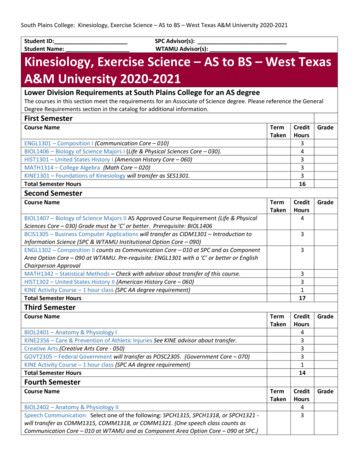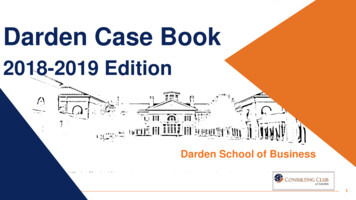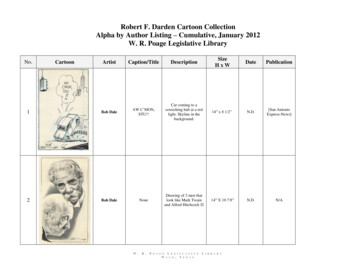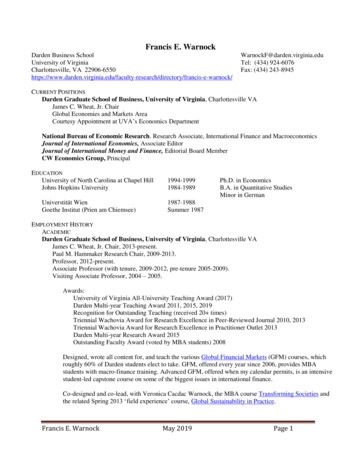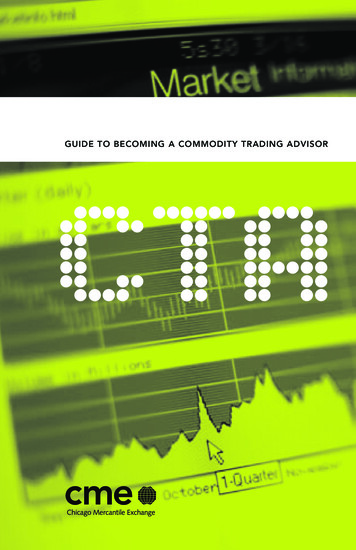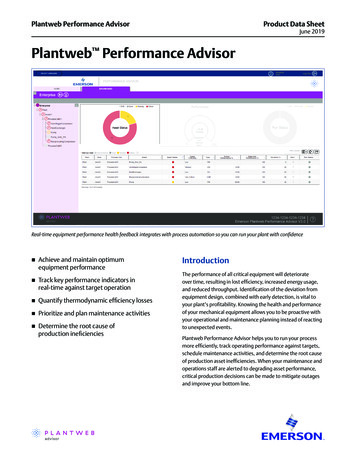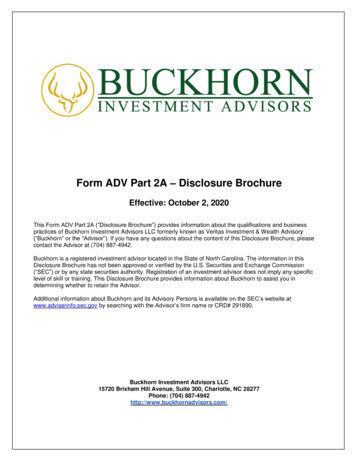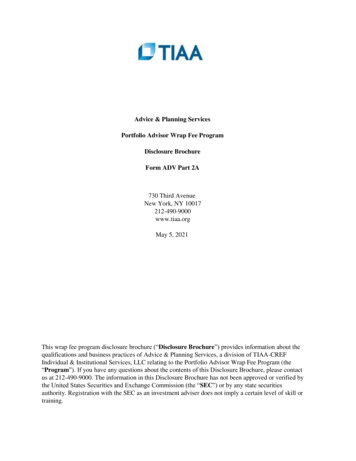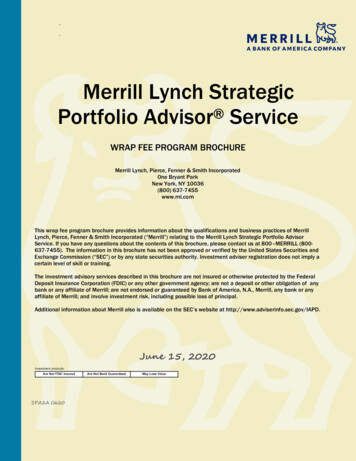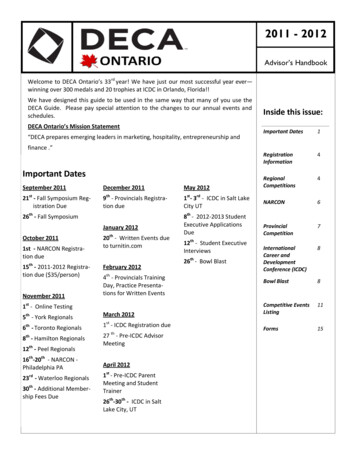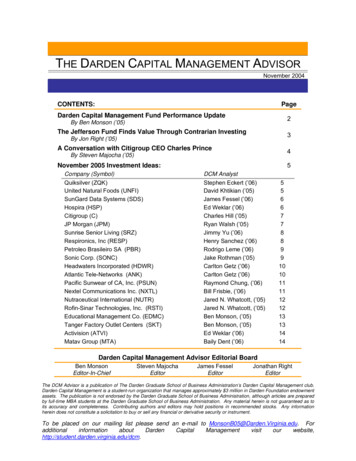
Transcription
THE DARDEN CAPITAL MANAGEMENT ADVISORNovember 2004CONTENTS:PageDarden Capital Management Fund Performance Update2By Ben Monson (’05)The Jefferson Fund Finds Value Through Contrarian Investing3By Jon Right (’05)A Conversation with Citigroup CEO Charles Prince4By Steven Majocha (’05)5November 2005 Investment Ideas:Company (Symbol)DCM AnalystQuiksilver (ZQK)United Natural Foods (UNFI)SunGard Data Systems (SDS)Hospira (HSP)Citigroup (C)JP Morgan (JPM)Sunrise Senior Living (SRZ)Respironics, Inc (RESP)Petroleo Brasileiro SA (PBR)Sonic Corp. (SONC)Headwaters Incorporated (HDWR)Atlantic Tele-Networks (ANK)Pacific Sunwear of CA, Inc. (PSUN)Nextel Communications Inc. (NXTL)Nutraceutical International (NUTR)Rofin-Sinar Technologies, Inc. (RSTI)Educational Management Co. (EDMC)Tanger Factory Outlet Centers (SKT)Activision (ATVI)Matav Group (MTA)Stephen Eckert (’06)David Khtikian (’05)James Fessel (’06)Ed Weklar (’06)Charles Hill (’05)Ryan Walsh (’05)Jimmy Yu (’06)Henry Sanchez (’06)Rodrigo Leme (’06)Jake Rothman (’05)Carlton Getz (’06)Carlton Getz (’06)Raymond Chung, (’06)Bill Frisbie, (’06)Jared N. Whatcott, (’05)Jared N. Whatcott, (’05)Ben Monson, (’05)Ben Monson, (’05)Ed Weklar (’06)Baily Dent (’06)556677889910101111121213131414Darden Capital Management Advisor Editorial BoardBen MonsonEditor-In-ChiefSteven MajochaEditorJames FesselEditorJonathan RightEditorThe DCM Advisor is a publication of The Darden Graduate School of Business Administration’s Darden Capital Management club.Darden Capital Management is a student-run organization that manages approximately 3 million in Darden Foundation endowmentassets. The publication is not endorsed by the Darden Graduate School of Business Administration, although articles are preparedby full-time MBA students at the Darden Graduate School of Business Administration. Any material herein is not guaranteed as toits accuracy and completeness. Contributing authors and editors may hold positions in recommended stocks. Any informationherein does not constitute a solicitation to buy or sell any financial or derivative security or instrument.To be placed on our mailing list please send an e-mail to MonsonB05@Darden.Virginia.edu. du/dcm.
Darden Capital Management Fund Performance UpdateBy Ben MonsonIn its fourteen year history, Darden CapitalManagement (DCM) has delivered an averageannual total return of 12.1%—a cumulative 14year total return of 330%. This is an extraordinaryrecord for a diversified long-only fund. Thisrepresents an average annual outperformance of1.3% relative to our benchmark. DCM’s returnshave exceeded our benchmark in 11 of 14 yearsthat the fund has been in existence. On acumulative basis, DCM has outperformed thebenchmark by 50% over 14 years.Theseresults—combined with our strong gement into the top quartile of mutual fundsin the United States.Jefferson FundInvestment Focus: Value, contrarian 20 equity positions Mid cap, flexibleBenchmark: 70% equity, Russell 1000 10% REIT, RMS Index 20% debt, Lehman Treas.BenchmarkIllustrative Positions: LaFarge (LAF) Tanger Outlet Cent. (SKT) International Steel (ISG)Returns: 1.9% cumulative YTD vs.benchmark’s 0.6% October—4.0%Cumulative Portfolio ReturnsJefferson 0/0407/31/0408/31/0409/30/0410/31/04thThe current (15 ) DCM fund management teamhas continued this tradition of strong performanceduring the first half of fiscal 2005. As of the end ofOctober, each of Darden Capital Management’sthree funds has delivered strong returns in achoppy equity market.Year to date (since April 1st), the Darden Fund,Monticello Fund, and Jefferson Fund haveproduced total returns of 1.9%, 3.3%, and 1.0%,respectively.Two of the three funds haveoutperformed their benchmarks year to date, andthe funds’ combined performance has solidlyoutperformed the combined benchmark. Octoberwas a particularly strong month for the Dardenand Jefferson funds as investment theses fromearlier stock picks played out. The JeffersonFund returned 4.0% in October and the DardenFund returned 2.3%.The table to the right shows each fund’sinvestment focus, benchmark, returns, andsample equity positions.Monticello FundInvestment Focus: Value and growth 25 equity positions Large and mid capBenchmark: 80% S&P 1000 20% debt, Lehman Treas.BenchmarkIllustrative Positions: American Standard (ASD) Anheuser-Busch (BUD) Citigroup (C)Returns: 1.0% cumulative YTD vs.benchmark’s 1.1% October—1.1%Cumulative Portfolio /31/0406/30/0407/31/0408/31/0409/30/04Darden FundInvestment Focus: Small cap ( 2 bil.) 40 equity positions Growth and valueBenchmark: 75% equity, S&P 600 20% fixed income 5% cashBenchmarkIllustrative Positions: Sonic Corp. (SONC) WD-40 Co. (WDFC) Headwaters (HDWR)Returns: 3.3% cumulative YTD vs.benchmark’s 2.8% October—2.3%Cumulative Portfolio ReturnsDarden Fund5%3%1%-1%8-3%-5%-7%3/31/04Darden Capital Management Advisor5/1/046/1/047/2/048/2/049/2/0410/3/04(2)
Fund Focus: The Jefferson Fund Finds Value Through Contrarian InvestingBy Jon Right and Ben MonsonThe Jefferson Fund seeks out-of-favor and undervalued investment opportunities. The Fund allocatesapproximately 70% of its portfolio to value equities, 10% to real estate investment trusts (REITs), and20% to US Treasury securities or cash. The equity portfolio is primarily made up of stocks that are: (1)attractively valued relative to historical multiples, comparables, and the broader market, (2) turnaroundstories, and (3) out of favor stocks and/or out of favor industries. The Fund employs a bottom-up,fundamental approach to securities selection, and focuses on finding value in mid-cap companies. Thefund managers believe that stocks that have suffered from short-term fundamental setbacks, reducedanalyst coverage, or negative market sentiment often represent strong upside potential with a lower levelof risk, especially when the market has overreacted to changes in the company’s short-term prospects.The Fund underperformed its benchmark during the first half of FY2005 (April through September 2004).As a value-oriented and long-term investment fund, many of the Fund’s positions remained out of favor inthe early part of the fiscal year, especially during the “soft patch” in the market in July and August. TheFund returned 4.0% in October, reversing this trend and leading to modest year-to-date outperformance.Several of the Fund’s investment theses played out in October, leading to the strong performance.BenchmarkCumulative Portfolio ReturnsJefferson 0/0407/31/0408/31/0409/30/0410/31/04The following are examples of the Fund’s portfolio stocks that illustrate its investment style.Value Stocks: LaFarge is the largest producer of gypsum and cement in North America, and the thirdlargest producer of aggregates. This is a classic value stock—it is a strong cash flow company in agrowing (primarily commercial construction supply) industry combined with an inexpensive valuation.This stock traded at a substantial discount to its historical average, comparables, and the market. Thisinvestment has yielded a return to the Fund in excess of 17% YTD.Turnarounds: International Steel Group (ISG) is an excellent example of a turnaround company in theJefferson Fund portfolio. ISG is essentially a roll up of the steel production assets of bankrupt integratedsteel companies, with reduced labor, environmental, and contingent liabilities and a considerably lowercost structure relative to other integrated steel companies. ISG is in the process of being acquired by acompetitor and our total return from the stock is in the 30% range.Out of Favor Stocks: Nokia (NOK) is a stock that was oversold as a result of negative market sentimentdriven by temporarily soft fundamentals. The Fund purchased NOK shares after the market sold it off inMay, and again over the summer, in response to market share losses and negative guidance revisions.The price fell over 40% at the trough in the market. Notwithstanding the market share challenges, Nokiawas still the most recognizable name in mobile phones and its price-to-earnings ratio was trading at a50% discount to the telecommunications equipment sector and a whopping 75% discount to rivalMotorola (MOT). In addition, the company had no debt and 9 billion in cash on its balance sheet tospend on a revitalization program. Following the second investment, Nokia has gained 27% and is nowthe largest equity position in the portfolio.Darden Capital Management Advisor(3)
Fixed Income Strategy: The Jefferson Fund managers acted to reduce the fixed income portfolio’sinterest rate sensitivity in September. The managers developed an outlook for a modest steepening ofthe yield curve and purchased what’s known as a “barbell” fixed income strategy between 2-year and 10year treasury notes to arrive at a portfolio target duration around 4.15 years. In this way, the Fund retainsa portfolio duration lower than its benchmark, but is hedged against yield curve flattening by purchasing 50,000 worth of 10-year notes.Round Table Discussion with Chuck PrinceBy Steven Majocha (’05)During my internship over the summer as a sell-side analyst at Citigroup, I had the opportunity toparticipate in a round table discussion with Citigroup CEO Chuck Prince. Two of the three Darden CapitalManagement funds—the Monticello Fund and the Jefferson Fund—currently hold Citigroup stock, whichwe believe is relatively undervalued. The DCM editorial board felt that a candid discussion with Citigroupsenior management concerning the future direction of the firm and its current regulatory issues would beof interest to current and potential investors.While a variety of topics were discussed throughout the meeting, Mr. Prince identified three challengesthat Citigroup must face that will shape the future direction of the company. Those challenges arecontinued growth, corporate governance, and human resource issues.Continued Growth: How can a company as large as Citigroup continue to grow? According to Prince,organic growth will replace the company’s recent history of growth through acquisition. One of the mainreasons for the company’s change in strategy in regard to acquisition is a result of the sheer size of theorganization. It is generally believed by management that the company is too big to be meaningfullyimpacted by future acquisitions. Therefore, management has continued to improve its capital allocationprocess to fund internal projects that offer the highest rates of return to maximize future organic growth.Corporate Governance: Compliance risk continues to be a major focus at Citigroup. Mr. Princerecognizes that Citigroup’s prominence often leads to scrutiny by regulators and investors alike. Heacknowledges that Citigroup’s must operate in a more cautious and responsible way than its smallercounterparts. In order to steer clear from future mishaps, Mr. Prince believes that designing andinternalizing best practices for managing compliance risk will be important to avoid controversialheadlines in the future. Citigroup’s most recent troubles in Japan are a prime example of the compliancerisk the company faces.Human Resources: People issues are possibly the most important challenges facing Citigroup today. Inthe words of Mr. Prince, “Creating a culture and environment for people to grow, for people who arestarting their careers, for people in the middle, and for people who are ending their careers is the mostconsequential thing that will determine whether Citigroup continues to grow and achieve the fullness of itspotential.” To achieve this goal, Mr. Prince believes creating small companies within a large one, wherepeople feel that they make a difference and are not a cog in a wheel will help Citigroup attract the besttalent.Shares of Citigroup have traded down over the past six months due to compliance issues in Japan andthe effect of rising interest rates on its underlying business. At its current valuation, Citigroup representsa potentially attractive investment. Please see Charles Hill’s Citigroup pitch on page 7.Darden Capital Management Advisor(4)
November 2004 Investment IdeasQuiksilver, Inc. (ZQK— 25.87)Stephen Eckert, ‘06EckertS06@darden.virginia.eduUnited Natural Foods, Inc. (UNFI— 26.79)David Khtikian, ‘05KhtikianD05@darden.virginia.eduTarget Price: 31.00Market Capitalization: 1.5 Bil.Target Price: 34.00Market Capitalization: 1.1 Bil.Description: Quiksilver, Inc. is a specialty apparelcompany focused on the design, production, anddistribution of clothing for individuals who enjoy theextreme sports lifestyle of “surf, skate, and snow”.The products range from t-shirts, board-shorts, andwet-suits to skate shoes and snowboard gear. Theproducts are sold primarily at surf shops, specialtystores, and Boardriders Club stores.Description: United Natural Foods, Inc. (UNFI) isa national distributor of natural and organic foodsand related products in the United States. Thecompany carries more than 35,000 natural andorganic products, consisting of national brand,regional brand, private-label, and masterdistribution products such as grocery and generalmerchandise. UNFI serves more than 18,000customers, including independently owned naturalproducts retailers, supernatural chains (includingWhole Foods and Wild Oats) and conventionalsupermarkets.Positive Considerations: Trends strongly suggestthat extreme sports are quickly growing inpopularity, driving demand for this type of clothing.Quiksilver offers the widest range of quality apparelwithin this space.Revenue has grown from 446 million in 1999 to 975 million in 2003. The age group loyal to thebrand has expanded through endorsements fromextreme athletes Kelly Slater and Tony s”—including a new Times Square NYC store.The acquisition of DC Shoes expands thecompany’s footwear offerings and is a logical brandextension for Quiksilver. The company has alsoexpanded with a new women’s line, Roxy, andEurope is a key growth market for Quiksilver.Positive Considerations:In an attractiveindustry (organic food industry growing at anannual rate of 8% v. 2% for conventional food),UNFI presents an excellent long term investmentbased on future earnings growth, continuedoperational efficiency improvement, soundmanagement, and loyal customer relationships.Risks: Risks include the potential decline in thenatural food trend due to reduced healthconsciousness and UNFI’s reliance on WholeFoods Market (WFMI) for sales.Risks: Competition within the industry is fierce andcutting edge vision is required to stay ahead ofpopular trends. There are also risks inherent tofurther expansion into international operations.UNFI’s stock has ridden the Whole Foods (WFMI)and Wild Oats’ (OATS) wave in performance. Webelieve it will continue to benefit from the battle formarket share and location between these twocompetitors as both sides’ primary distributor.Valuation: Our buy recommendation is basedupon realistic bottom line growth potential of 20% in2005. Our 31 price target is based on a P/Emultiple of 20x on estimated 2004 EPS of 1.55.Valuation: Our buy recommendation is based onthe positive fundamentals and positive valuationof the company. We believe that UNFI shares’intrinsic value is 34 based on a DCF model.Darden Capital Management Advisor(5)
SunGard Data Systems. (SDS— 25.95)James J. Fessel, CFA, ‘06FesselJ06@darden.virginia.eduHospira, Inc. (HSP— 29.72)Ed Weklar, ‘06WeklarE06@darden.virginia.eduTarget Price: 36.00Market Capitalization: 7.7 Bil.Target Price: 36.00Market Capitalization: 4.7 BillionDescription:SunGard provides software andprocessing systems that serves more than 20,000clients in more than 50 countries. The firm operatesthrough three main divisions – Investment SupportSystems (ISS), and Higher Education & PublicSector Systems (HEPSS) and Availability Services(AS).Description: Hospira, Inc. is a specialtypharmaceutical and medication delivery companythat is focused on developing, manufacturing andmarketing products that improve the safety andefficacy of patient care in the acute care setting.The company operated as a division of AbbottLaboratories until it was spun-off in April 2004.Hospira had LTM revenue and EBITDA of 2.6billion and 518.5 million, respectively.Positive Considerations: Sungard has built aconsistent track record of double-digit earningsgrowth, reinforced by tremendous barriers to entryin its core software and data processing business,high switching costs, deep client penetration, andover 90% recurring revenue. The recent positivemomentum in organic revenue growth looks to bethe beginning of a long cycle of improving demand,particularly from major clients in the financialservices industry.Increased trade volumes,greater demand for regulatory and compliancesystems, and a consolidation of vendors all playwell into SunGard’s hands. Near-term catalystsinclude the announced spin-off of its AvailabilityServices unit in a tax free distribution toshareholders expected in early ons, a downturn in the stock market ordecline in overall equity trading volumes, or a sharpdecline in technology spending in the financialservices industry could hurt sales and profits.Valuation: Our 12-month target price of 36represents a multiple of 23x our 2005 EPS estimateof 1.59 (PEG of 1.2x), close to the low end of thecompany’s historical trading range of 20x-32x 12month forward earnings, and consistent with theaverage premium of 20%-40% over the marketmultiple. We would expect SunGard to trade up tothis multiple level as internal growth improves in theISS segment and investors gain visibility on theearnings numbers for next year.Darden Capital Management AdvisorPositiveConsiderations:Thisnewlyindependent company can focus on new growth &profit initiatives. There is room for significantmargin improvement, as EBITDA margins are 3040% below those of competitors. The companyshould also benefit from favorable demographicsas the U.S. population ages. Hospira has astrong market position as 90% of the company’sproducts are #1 or #2 in its markets. Hospira’sstock is undervalued compared to comparablecompanies, trading at 10.2x LTM EBITDA vs.public comparables at 12.6x and a discount to tworecent industry transaction multiples of 15.0x.After the IPO in April, Hospira insiders acquiredapproximately 4 million worth of shares.Risks: The company may encounter difficultiesdeveloping infrastructure.Analysts forecastlimited revenue and earnings growth as AbbottLabs continues to pull business from Hospira andrevenue from certain products declines due tocompetition from generics. Additionally, the stockis up nearly 25% from its all-time low (but only 7%from its IPO). Hospira is up against strongcompetitors, such as Baxter International,Cardinal Health, and Teva Pharmaceutical.Valuation:Hospira’s stock is undervaluedcompared to comparable companies, trading at10.2x LTM EBITDA vs. public comparables at12.6x and recent acquisitions of two competitorsat 15.0x.(6)
Citigroup (C— 46.82)Charles Hill, CFA, ‘05HillC05@darden.virginia.eduJPMorgan Chase & Co. (JPM— 39.33)Ryan Walsh, ‘05WalshR05@darden.virginia.eduTarget Price: 55.00Market Capitalization: 243 Bil.Target Price: 45.00Market Capitalization: 140 Bil.Description: Citigroup Inc. is a financial servicesholding company that conducts its activities throughthe Global Consumer (54%), Global Corporate andInvestment Bank (33%), Private Client Services(5%), Global Investment Management andProprietary Investment Activities segments (9%).Description: JPMorgan Chase is the 2nd largestfinancial services firm in the U.S. Following theJuly 2004 merger with Midwest banking g
spironics, Inc (RESP) nry Sanchez (’06) troleo Brasileiro SA (PBR) drigo Leme (’06) nic Corp. (SONC) ke Rothman (’05) adwaters Incorporated (HDWR) rlton Getz (’06) lantic Tele-Networks (ANK) rlton Getz (’06) cific Sunwear of CA, Inc. (PSUN) ymond Chung, (’06) x
